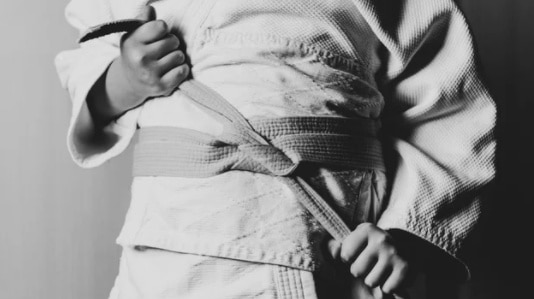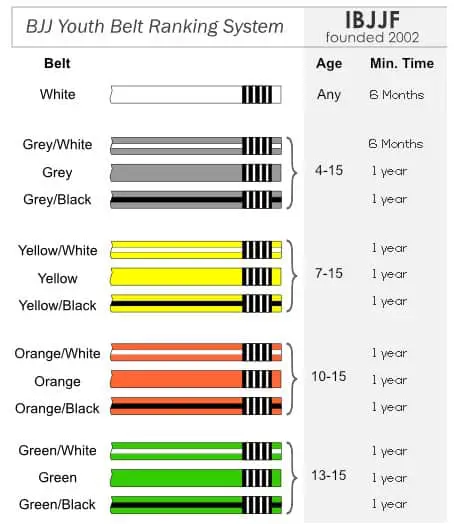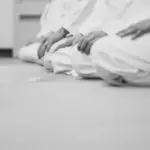Brazilian Jiu-Jitsu is a martial art that is gaining in popularity. It focuses on ground combat, and it offers a great mode of self-defense. While many adults practice Brazilian Jiu-Jitsu, it is also gaining popularity with children. Kids gain a lot from practicing Brazilian Jiu-Jitsu, and the kids belt system in BJJ keeps them motivated.
The belt system for kids in Brazilian Jiu-Jitsu starts at the age of four and continues until they turn fifteen. After they turn fifteen, they will start progressing in the adult belt system. Additionally, if they have accomplished all the belt rankings in the kids system then they can start at the blue level of the adult system instead of white.
Having a belt system in place helps the kids stay focused on their goals within martial art. It is easy for children to get discouraged, and these belts are designed to keep them encouraged. Read on to discover more about the kids’ belt system in Brazilian Jiu-Jitsu.
The Brazilian Jiu-Jitsu Belt System
Before understanding the kids’ belt system in BJJ, it is important to understand how the belt system came to be, and why it exists today. One only needs to look briefly at the history of this martial art to see the origins of the modern belt system.
Belts have been used in martial arts for thousands of years. However, for most of that time, there were only two colors. The two colors were white and black. Beginner students would wear the white belt and once they mastered the martial art, they would transition to black.
This is very different from the belt system implemented in modern martial arts. The belts in today’s modern martial arts came from Dr. Jigoro Kano. Essentially, he created a belt system so he could track the progress of his students.
Today, Brazilian Jiu-Jitsu uses two sets of colored belts: one for kids and one for adults. A quick breakdown of the two sets of colors shows how they differ.
- The kids belt system has five color groups: white, gray, yellow, orange, and green. Within these color groups, there are further designations.
- The adult belt system has eight color groups: white, blue, purple, brown, black, white/red, black/red, and red.
- Each system includes a strip-based system. With the acquisition of new skills, the student will receive stripes to their belt, which aids in the progression to the next color group.
The belt system is important for both kids and adults alike. They wear them as a source of pride. It shows how far they have come in their BJJ studies.
The Kids Belt System in BJJ
The kids belt system in BJJ is designed with children in mind. It can seem a bit complex at first, but once put into practice it is fairly straightforward. Moreover, the belt system is an important part of Brazilian Jiu-Jitsu when it comes to kids.
The belt system for kids in Brazilian Jiu-Jitsu starts at the age of four and continues until they turn fifteen. After they turn fifteen, they will “graduate” to the adult belt system. Additionally, if they have accomplished all the belt rankings in the kids system they can start at the blue level of the adult system instead of white.
So, what are the belt rankings for the kids system? It is broken down into five color groups, which are then broken down even more with stripes.
- White belt. The white belt is the same as the adult white belt, except there are 5 stripes instead of 4 that are used on the adult belt.
- Gray belt. The gray belt has three levels: gray with a white lengthwise stripe, a solid gray belt, and gray with a lengthwise black stripe.
- Yellow belt. The yellow belt also has three levels: yellow with a white lengthwise stripe, solid yellow, and yellow with a lengthwise black stripe.
- Orange belt. As with gray and yellow, the orange belt has three subcategories that include white stripes, solid orange, and black stripes.
- Green belt. The green belt, which is the highest a kid can reach, is set up in the same way as the previous belts.
The minimum age level of each belt is different. For example, when you are seven years old you are eligible to start any belt from white up to yellow with the white lengthwise stripe. You could not, however, go above this at this age.
The belt system, even for kids, is very structured. You move on to a higher level once you have completed the training necessary to do so.
A Detailed Look at the Belt System
As mentioned, the Brazilian Jiu-Jitsu belt system for kids has five color groups. Each one has its necessary building blocks for success. To progress forward, children need to spend time training.
The amount of time it takes to progress from each belt varies by student. However, a general time frame can be calculated. The average time it takes to progress to the next belt in a subcategory is around eight months. Furthermore, to progress through an entire color group, it will take around two years of training.

Each color category is considered a level in kids Brazilian Jiu-Jitsu. For example, the white belt group is considered a beginner. The next two color groups, gray and yellow, are considered intermediate. The final two color groups, orange and green, are considered advanced.
Within each color category, there are many stripes to be gained by the child. Each color group, except for white, has three levels. It goes from a white lengthwise stripe to a black lengthwise stripe. To get to each belt, the child must obtain four white vertical stripes, four red vertical stripes, and three black vertical stripes.
Age Groups
The kids belt system follows a certain order when it comes to the age of the student. Any student, regardless of their age, can begin with white. However, the same is not true of the other belt categories. Each category has three age groups.
- Gray color group: The first level of the gray color group studies between ages 4 and 15. The second level studies between ages 5 and 15, and the third level studies between 6 and 15.
- Yellow color group: The first level of the yellow color group studies between ages 7 and 15. The second level studies between ages 8 and 15, and the third level studies between 9 and 15.
- Orange color group: The first level of the orange color group studies between ages 10 and 15. The second level studies between ages 11 and 15, and the third level is studied between 12 and 15.
- Green color group: The first level of the green color group studies between ages 13 and 15. The second level studies between 14 and 15, and the final level can only be studied at the age of 15.
These age groups give the children milestones. It also creates a way to track the progress of the child because as they progress through the belt system, the belts will correlate with age.
Belt Stripes
The stripes on the belt signify that the student has completed certain skills within each color group category. These stripes are given out by the instructor and at their discretion.
However, these stripes must be obtained to progress through the belt system. They are a visual representation of incremental steps. When the instructor decides that a student is ready for their next vertical stripe, they will present it to them.
Each belt needs a certain number of stripes to continue. As mentioned, this means they need four white vertical stripes, four red vertical stripes, and three black vertical stripes. These are placed on the belt itself next to each other.
Once a student has received all eleven stripes, they proceed to the next belt. For example, if a student has a yellow belt with a lengthwise white stripe and they receive all eleven vertical stripes, they would then proceed to a solid yellow belt. The process would then repeat itself.
How Does An Instructor Decide on Stripes?
There are certain elements every instructor is going to look at when deciding whether to hand stripes out or not. While kids do move through the belt system quicker than adults, they still need to meet certain criteria to progress.
An instructor will look at each student individually. There is no ceremony for everyone getting their belt. Rather, the instructor will give each student their stripes and belts when they believe they deserve it.
So, what does an instructor look for specifically? The criteria are similar to the adult system. They will look at:
- Technical abilities. Each level has its technical abilities that the student must learn and master. The instructor will award stripes when he sees that these technical abilities have been mastered.
- Time spent training. Each category of the belt system has a general time frame attached to it. While there is no specific time for the kids belt system, it is usually around eight months. The instructor will take the time the child has been studying at a certain level into account when awarding stripes and belts.
- Overall performance. The overall performance of the student is important. The instructor must see that they are retaining the skills they are learning and are performing at the proper level for their age and their belt level.
The belt stripes keep the kids motivated. They want to get the next stripe on their belt so that can continue to progress toward the green and black belt. The belt system is designed to encourage, and the inclusion of these stripes fulfills that design.
What Is Learned At Each Level?
Each level of the kids belt system in Brazilian Jiu-Jitsu has its own set of skills that the child will learn. Additionally, each category will build off the previous one so that the student is learning foundational skills that will help them as they progress.
But what skills are focused on in each belt category? Generally speaking, each category will teach the student skills necessary to excel in the subsequent color group.
- White belt. The white belt category is the most simple one in the system. Usually, the youngest children are in this category, though a child of any age can be a white belt. In this category, you are learning the most basic of skills.
- Gray belt. In the gray belt category, the main focus is generally escapes and control. This may vary based on where they are learning, but this will most likely be the focus.
- Yellow belt. In the yellow belt category, the kids are focusing on the sports aspect of Brazilian Jiu-Jitsu. Additionally, the yellow belt will continue to work on the skills acquired in the gray belt. This is because both the gray and yellow belts are considered intermediate.
- Orange belt. This is the first category that is considered advanced. As such, they are going to focus on more complex and advanced moves. These movies will require the child to transition between moves.
- Green belt. This is the highest belt a kid can receive. This means that it has the most advanced moves. Sometimes, depending on the skill and size of the kid, they may practice with an adult. These moves will be the most complex yet and will prepare them for the adult system, which they can move to at age sixteen.
Once the student completes all the training for the kids belt system, they can then progress to the adult system at the age of sixteen. If they have acquired the green belt, then they can start at the blue belt in the adult system.
Being able to start at the blue belt in the adult system is a huge step forward. It shows that they have acquired the skills and discipline to handle the adult system without having to revert to the white belt.
The Importance Of The Belt System
Brazilian Jiu-Jitsu is a very disciplined martial art. It is also one of the most beneficial for young children. Brazilian Jiu-Jitsu teaches children many important lessons, such as:
- Discipline. To progress through the belt system, you need discipline. The training is structured and builds upon what the child has already learned. The hierarchy of the belt system is important and cannot be bypassed.
- Courage. Brazilian Jiu-Jitsu is a combat-based martial art. To do well, you must learn courage.
- Respect. Respect is necessary. You must respect not only your opponent but the training and the belts you receive during your training.
- Critical Thinking. Critical thinking comes with training in any discipline, and the same is true for Brazilian Jiu-Jitsu.
With a discipline such as Brazilian Jiu-Jitsu, it is important to have a structured system to monitor how the students are doing. The belt system offers a way to track how each child is progressing.
Children love the belt system. Children as young as four can partake in Brazilian Jiu-Jitsu, and the belt system is a type of reward system. It shows them that they are progressing. Oftentimes, even with adults, it can be difficult to see the progress you are making.
Kids who are studying Brazilian Jiu-Jitsu will learn how to respect the martial art. It is not enough to just want to get the next belt, though this is a large part of it early on. It is necessary to learn the important and cultural aspects of the art form. The belt system will slowly teach them this.
They will also learn that belts are not everything. There is more to Brazilian Jiu-Jitsu than just the color of the belt they wear around their waist. It is about the lesson they are learning, and the skills they are acquiring.
The Belt System Offers Encouragement
The belt system offers encouragement to kids, as already mentioned. However, it also keeps them focused on their tasks.
The skills that the kids are learning in Brazilian Jiu-Jitsu come about incrementally. It is easy to lose sight of what you are learning when you are learning in small chunks. This is what makes the belt system so important.
For example, if the kids belt system were to only use the original two-color system, there would be a vast gap between beginner and advanced. Most people, kids included, want to see that they are making progress. When you see that you are making progress you are more likely to continue onward.
So, the belt system in Brazilian Jiu-Jitsu for kids is built so that they can see progressions between beginner and advanced. It keeps them focused, and it keeps them wanting to learn more.
Moreover, it is a way to encourage each other in the class. Often, different students will be at different levels even if they started at the same time. You want to keep up with your friends, so you will put in more effort.
Why Do Kids Have A Different Belt System?
The adult belt system in Brazilian Jiu-Jitsu is more intense than the kids belt system. The adult belt system includes more color categories than the kids system. Moreover, it also includes a lot more time and training.
For example, to master the black belt before moving to a red belt, an adult must spend decades training at that single belt. The time needed for each level also varies between belts. A lower belt will take less time than a belt that is more advanced.
This is why kids have a separate belt system. Kids need to have a less complex and less intense system to work off of. For example, if a child needed to spend multiple years at a single belt without any visual progress, they would be more likely to stop.
Additionally, children’s abilities can vary greatly, so having a more diverse belt system helps track progress more efficiently.
However, the kids belt system is designed so that they are receiving stripes consistently. Each belt takes around eight months, but within those eight months, they are receiving eleven stripes.
Conclusion
The kids belt system consists of 13 belts, with 5 color groups: white, gray, yellow, orange, and green. Each color group, except white, has 3 belts: the belt color with a horizontal white stripe through the middle, solid color, and belt color with a horizontal black stripe through the middle.
A student with the white belt requires 5 (vertical) stripes to progress to the next belt level (the last one being red). Whereas the other belts require 11 vertical stripes before progressing to the next level: 4 white stripes, 4 red stripes, and 3 black stripes.
A student must be 16 before they are able to progress to the adult belts and recieve their blue belt.



